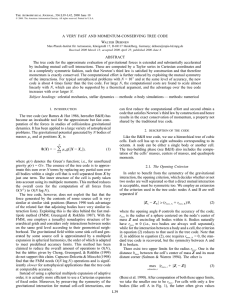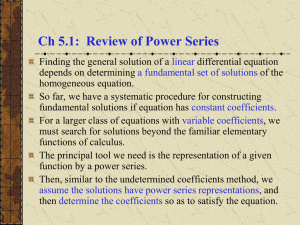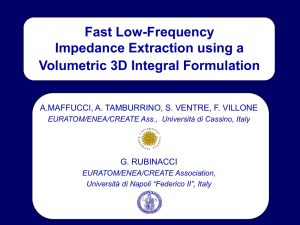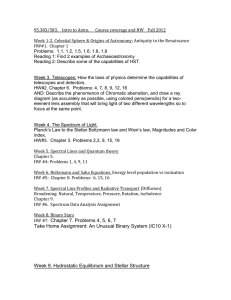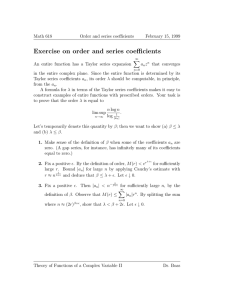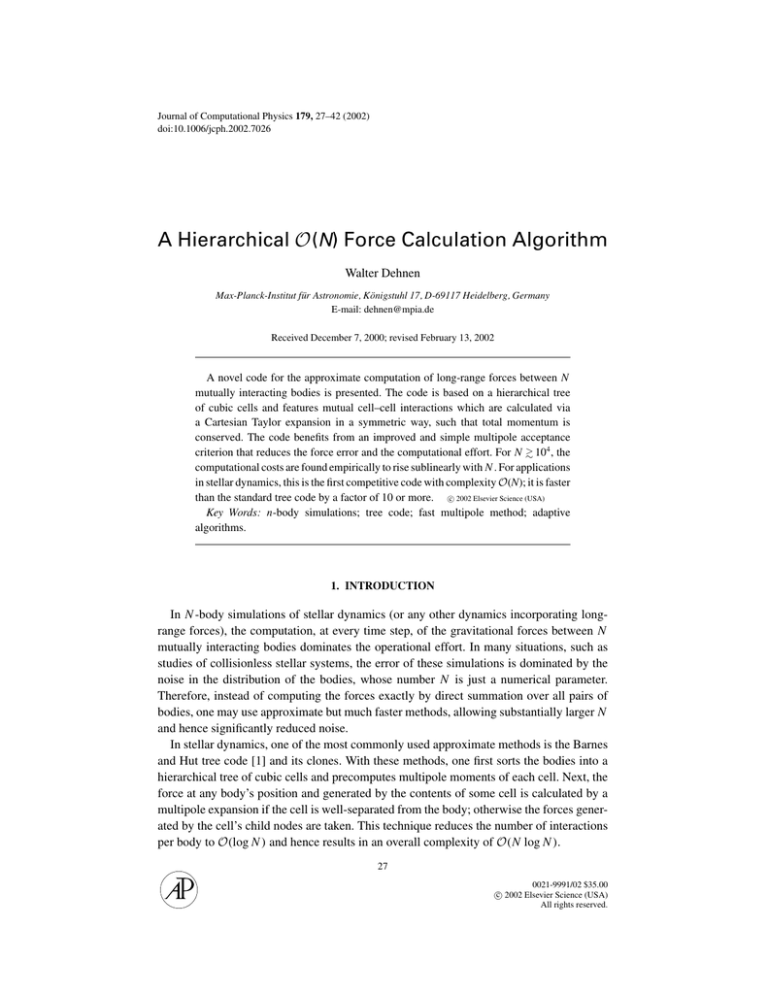
Journal of Computational Physics 179, 27–42 (2002)
doi:10.1006/jcph.2002.7026
A Hierarchical O(N) Force Calculation Algorithm
Walter Dehnen
Max-Planck-Institut für Astronomie, Königstuhl 17, D-69117 Heidelberg, Germany
E-mail: dehnen@mpia.de
Received December 7, 2000; revised February 13, 2002
A novel code for the approximate computation of long-range forces between N
mutually interacting bodies is presented. The code is based on a hierarchical tree
of cubic cells and features mutual cell–cell interactions which are calculated via
a Cartesian Taylor expansion in a symmetric way, such that total momentum is
conserved. The code benefits from an improved and simple multipole acceptance
criterion that reduces the force error and the computational effort. For N 104 , the
computational costs are found empirically to rise sublinearly with N . For applications
in stellar dynamics, this is the first competitive code with complexity O(N); it is faster
than the standard tree code by a factor of 10 or more. c 2002 Elsevier Science (USA)
Key Words: n-body simulations; tree code; fast multipole method; adaptive
algorithms.
1. INTRODUCTION
In N -body simulations of stellar dynamics (or any other dynamics incorporating longrange forces), the computation, at every time step, of the gravitational forces between N
mutually interacting bodies dominates the operational effort. In many situations, such as
studies of collisionless stellar systems, the error of these simulations is dominated by the
noise in the distribution of the bodies, whose number N is just a numerical parameter.
Therefore, instead of computing the forces exactly by direct summation over all pairs of
bodies, one may use approximate but much faster methods, allowing substantially larger N
and hence significantly reduced noise.
In stellar dynamics, one of the most commonly used approximate methods is the Barnes
and Hut tree code [1] and its clones. With these methods, one first sorts the bodies into a
hierarchical tree of cubic cells and precomputes multipole moments of each cell. Next, the
force at any body’s position and generated by the contents of some cell is calculated by a
multipole expansion if the cell is well-separated from the body; otherwise the forces generated by the cell’s child nodes are taken. This technique reduces the number of interactions
per body to O(log N ) and hence results in an overall complexity of O(N log N ).
27
0021-9991/02 $35.00
c 2002 Elsevier Science (USA)
All rights reserved.
28
WALTER DEHNEN
Another technique used frequently, for instance in molecular dynamics, is Greengard and
Rokhlin’s [2, 3] fast multipole method (FMM) and its variants. Traditionally, these methods
first sort the bodies into a hierarchy of nested grids, precompute multipole moments of each
cell, and then compute the forces between grid cells by a multipole expansion, usually in
spherical harmonics. That is, cells are not only sources but also sinks, which formally reduces
the complexity to O(N), although the author is not aware of an empirical demonstration in
three dimensions.1
Currently, no useful implementation of FMM for application in stellar dynamics exists.
In fact, it has been shown [5] that, for this purpose, the FMM in its traditional form cannot
compete with the tree code. The reason, presumably, is twofold: first, because stellar systems
are very inhomogeneous, nonadaptive methods and are less useful; second, FMM codes are
traditionally designed for high accuracy, whereas in collisionless stellar dynamics a relative
force error of few 10−3 is often sufficient.
Here, we describe in detail a new code, designed for application in the low-accuracy
regime, that combines the tree code and FMM, taking the best of each. In order to be fully
adaptive, we use a hierarchical tree of cubic cells. The force is calculated employing mutual
cell–cell interactions, in which both cells are source and sink simultaneously. Whether a
given cell–cell interaction can be executed or must be split is decided using an improved
multipole-acceptance criterion (MAC). The new code is a further development of the code
presented in [6], which in turn may be considered an improvement of a code given in [7].
It is substantially faster than the tree code and empirically shows a complexity of O(N) or
even less.
The paper is organized as follows. In Section 2, the numerical concepts are presented.
Section 3 describes the algorithm. In Section 4 the force errors are empirically assessed for
some typical stellar dynamical test cases. Section 5 presents empirical measurements of the
complexity and performance, also in comparison to other methods. Finally, Section 6 sums
up and concludes.
2. APPROXIMATING GRAVITY
The goal is to approximately compute the gravitational potential and its derivative, the
acceleration, at all body positions xi and generated by all other N − 1 bodies
(xi ) = −
j g(xi − x j ),
(1)
j=i
where i is the weight of the ith body. Consider two cells A and B (see Fig. 1), with centers
of mass zA and zB , respectively. The Greens function describing the mutual interaction
between a body at position x in cell A and a body at position y in cell B may be Taylor
expanded about the separation R ≡ zA − zB ,
p
1
g(x − y) =
(x − y − R)(n) ∇(n) g(R) + R p (g),
n!
n=0
(2)
where p is the order of the expansion, while R p denotes the Taylor series remainder (see
also Appendix A). Here, we follow Warren and Salmon [7] by using the notational shorthand
1
One of the most recent members of the FMM family, presented by Cheng et al. [4], still does not show clear
O(N) behavior at N = 106 (see, e.g., Table I of their paper).
A HIERARCHICAL O(N) FORCE CALCULATION
29
FIG. 1. Two interacting cells (boxes). Bodies are shown as solid dots. The stars indicate the positions of the
centers of mass, the solid and dotted circles around which have radii rmax and rcrit , respectively, for = 0.5.
in which x(n) indicates the n-fold outer product of the vector x with itself, while denotes
a tensor inner product. When inserting (2) into (1), whereby restricting the sum over j to all
bodies within cell B, we obtain for the potential at every position x in cell A and generated
by all bodies in cell B [7]
B→A (x) = −
p
1
m, p
(x − zA )(m) CB→A + R p (B→A ),
m!
m=0
p−m
(−1)n (n+m)
∇
g(R) MnB ,
n!
n=0
MnB =
i (yi − zB )(n) .
m, p
CB→A =
(3)
(4)
(5)
yi ∈B
The summation over m in Eq. (3) represents the evaluation of gravity, represented by the
m, p
field tensors CB→A , at the evaluation point x within the sink cell A. The computation of the
field tensors via the summation over n in Eq. (4) represents the interaction between sink
cell A and source cell B, represented by its multipole moments MnB .
The symmetry between x and y of the Taylor expansion (2) has the important consequence
that if Eqs. (3) and (4) are used to compute ∇B→A and ∇A→B , Newton’s third law is
satisfied by construction. For instance, the sum over all forces of N bodies vanishes within
floating point accuracy.
Note that the highest-order multipole moments, Mn= p , contribute only to the coefficients
C0, p and, hence, affect only but not ∇. Since in stellar dynamics the acceleration
rather than the potential is to be computed, one may well ignore M p , reducing CPU-time
and -memory requirements.
The formulae used in the standard tree code can be obtained by setting x = zA , corre0, p
sponding to body sinks. In this case, potential and acceleration are approximated by −CB→A
1, p
and CB→A , respectively.
2.1. Gravity between Well-Separated Cells
In our implementation, we stick to a third-order expansion ( p = 3), ignoring octopoles
M3B (see remark above). The dipole M1B vanishes by construction and the Taylor-series
30
WALTER DEHNEN
coefficients for spherical Greens functions read (with Einstein’s sum convention)
1
1
C0B→A = MB D 0 + M̃2Bii D 1 + Ri R j M̃2Bi j D 2 ,
2
2
1 2
1
1
1
2
2
3
2
2
CB→A,i = MB Ri D + M̃B j j D + R j Rk M̃B jk D + R j M̃Bi j D ,
2
2
C2B→A, i j = MB [i j D 1 + Ri R j D 2 ],
(6)
C3B→A, i jk = MB [(i j Rk + jk Ri + ki R j )D 2 + Ri R j Rk D 3 ],
where MB ≡ M0B is the mass of cell B and M̃2B ≡ M2B /M0B its specific quadrupole moment,
while
1 ∂ m
Dm ≡
g(r )
.
(7)
r ∂r
r =|R|
m
In practice, we calculate the coefficients C̃B→A ≡ MA Cm
B→A , because these obey the sym2
2
3
3
metry relations C̃B→A = C̃A→B and C̃B→A = −C̃A→B (for p = 3), which arise from the
mutuality of gravity. Since we consider always both directions of any interaction, exploiting these relations substantially reduces the operational effort.
2.2. Accumulating Taylor Coefficients
For each cell, after the coefficients of all its interactions have been accumulated as
m
m
C̃A = B C̃B→A , where the sum includes all interaction partners B of cell A, we transform
m
back to Cm
A = C̃A /MA . Next, for each body, the Taylor series of all relevant cells (those
that contain the body) have to be accumulated by first translating to a common expansion
center and then adding coefficients.
In contrast to expansions in spherical harmonics, the translation of the Cartesian expansion
m, p
(3) to a different center z is straightforward. Let C0 be the coefficients for expansion center
z0 ; then the coefficients for expansion center z1 are
m, p
C1
=
p−m
1
m+n, p
.
(z0 − z1 )(n) C0
n!
n=0
(8)
2.3. The Multipole Acceptance Criterion (MAC)
For the expansion (3) to converge, we must have |x − y − R| < |R| for all body–body
interactions “caught” by a single cell–cell (or cell–body) interaction (see Appendix A). In
order to ensure this, we first obtain, for each node, an upper limit rmax for the distance of any
body within the node from the center of mass (bodies naturally have rmax = 0). We take rmax
to be either the distance from the cell’s center of mass to its most distant corner [8], or [9]
max {ri,max + |z − zi |},
child nodes i
(9)
whichever is smaller. Then |x − y − R| < |R| ∀x ∈ A and y ∈ B, i.e., the nodes are wellseparated if
|R| > rA,crit + rB,crit
with rcrit = rmax /.
(10)
A HIERARCHICAL O(N) FORCE CALCULATION
31
The tolerance parameter controls the accuracy of the approximation: for Newtonian
forces, the error made in d dimensions by the pth-order expansion of the form (3) is
(Eq. (A.7))
|R p (∇B→A )| ≤
∝
( p + 1) p MB
(1 − )2 R 2
(11)
p+2
p+2
d−2
rB,max
∝
MB (d−2)/d ,
2
(1 − )
(1 − )2
(12)
d
where MB ∝ rB,max
has been assumed. Since MB /R 2 is, to lowest order, the acceleration
due to the interaction, Eq. (11) tells us that with constant , which is standard tree-code
practice, the relative error introduced by every single interaction is approximately constant.
Equation (12), however, shows that for the most important case of d = 3 this practice results
in larger absolute errors for interactions with bigger and hence on average more massive
cells. This implies that these interactions will dominate the total error of any body’s acceleration. It is, therefore, expedient to balance the absolute errors of the individual interactions,
which can be approximately achieved by using a mass-dependent tolerance parameter,
p+2
p+2
min
=
(1 − )2
(1 − min )2
M
Mtot
(2−d)/d
,
(13)
where Mtot is the mass of the root cell, while min = (Mtot ) is the new tolerance parameter.
If rA,max ∼ rB,max and MA ∼ MB , this method results in approximately constant absolute
acceleration errors. Note that Eq. (13) results in a very weak decrease of with increasing
mass: ∝ M−1/15 for d = 3, p = 3, and 1.
Instead of Eq. (12), one can obtain a stricter error limit incorporating the first p + 1
multipole moments (see Appendix A), which may be turned into a MAC [7]. However,
our choice (13) is (i) much simpler and (ii) overcomes already the main disadvantage of
= const, the variations of the absolute individual errors.
2.4. Direct Summation
For small N the exact force computation via direct summation is not only more accurate
than approximate methods but also more efficient. Therefore, we replace the approximate
technique by direct summation whenever the latter results in higher accuracy at the same
efficiency (see Appendix B for more details).
If an interaction is executed by direct summation, the Taylor coefficients of the interacting
0
1
cell(s) are not affected, but the coefficients C̃ and C̃ of the bodies within the cell(s) are
accumulated.
3. THE ALGORITHM
3.1. Tree Building and Preparation
In the first stage, a hierarchical tree of cubic cells is built, as described in [1], although
cells containing s or fewer bodies are not divided. Next, the tree is linked such that every
32
WALTER DEHNEN
cell holds the number of cell children2 , a pointer to its first cell child, as well as the number
of body children, of all body descendants, and a pointer to the first body child. Since cell
as well as body children are contiguous in memory (to arrange this we actually use tiny
copies of the bodies, called “souls,” which only hold a pointer to their body and its mass,
position, acceleration, and potential) these data allow fast and easy access to all cell and
body children of any given cell and to all bodies contained in it.
Next, the masses M, centers of mass z, radii rmax and rcrit , and specific quadrupole moments
2
M̃0 of each cell are computed in a recursive way from the properties of the child nodes.
3.2. A New Generic Tree-Walk Algorithm
One important new feature of our code is the mutual treatment of all interactions: both
interacting nodes are source and sink simultaneously. The standard tree walk, as for instance
implemented by the generic algorithm given in [7], and the usual FMM coefficient accumulation algorithm, e.g., in [4], contain an inherent asymmetry between sinks and sources and
thus cannot be used for our purposes. Instead, our algorithm approximates the forces in two
steps: an interaction phase, incorporating Eq. (4), and an evaluation phase, incorporating
Eq. (3).
3.2.1. The Interaction Phase
Because of the mutuality of the interactions, we cannot accumulate the Taylor coefficients
C̃ “on the walk,” but each node must accumulate the coefficients of all its interactions in its
0
3
own private memory. Cells need storage for C̃ to C̃ , while bodies only need to accumulate
0
1
C̃ and C̃ , i.e., potential and acceleration. The accumulation of these coefficients is done
using the following algorithm with the root cell for arguments A and B.
n
ALGORITHM 1 (INTERACT(NODE A, NODE B)).
try to perform the interaction between NODEs A and B;
// see Appendix B
if (it cannot be performed)
if (A = B)
// split cell self-interaction
for (all pairs {a, b} of child NODEs of A)
INTERACT(a, b);
else if (rmax (A) > rmax (B))
// split bigger node
for (all child NODEs a of A)
INTERACT(a, B);
else
for (all child NODEs b of B)
INTERACT(A, b);
Thus, if an interaction cannot be executed, using the formulae of the last section—see
Appendix B for details—it is split. In case of a mutual interaction, the bigger node is divided
and up to eight new mutual interactions are created, while a self-interaction of a cell results
in up to 36 new interactions between its child nodes. In practice, we use a nonrecursive
code incorporating a stack of interactions.
2
Hereafter “child” means a direct subnode of a cell, while “descendant” refers to any node contained within a
cell, including the children, the grandchildren, and so on.
A HIERARCHICAL O(N) FORCE CALCULATION
33
3.2.2. The Evaluation Phase
Finally, the Taylor coefficients relevant for each body are accumulated and the expansion
is evaluated at every body’s position. After transforming C̃ to C for every cell and body,
this is done by the following recursive algorithm, which is initially called with the root cell
and an empty Taylor series as arguments.
ALGORITHM 2 (EVALUATE GRAVITY(CELL A, TAYLOR SERIES T0 )).
T A = TAYLOR SERIES due to the Cn of CELL A;
translate center of T0 to center of mass of A;
T A += T0 ;
for (all BODY children of A) {
evaluate T A at BODY’s position;
add to BODY’s potential and acceleration;
}
for (all CELL children C of A)
EVALUATE GRAVITY(C, T A );
// using equation (8)
// add up coefficients
// as in equation (3)
// recursive call
Thus, the coefficients of the Taylor series that is eventually evaluated at some body’s
position have been added up from all hierarchies of the tree and hence account for all
interactions of all cells that contain the body.
4. ERROR ASSESSMENT
Two types of force errors are involved in collisionless N -body simulations of stellar
dynamics. One is the unavoidable error between the smooth force field of the underlying
stellar system modeled and the forces estimated from the positions of N bodies (which are
sampled from this stellar system). This estimation error can be reduced by increasing the
number N of bodies in conjunction with a careful softening: the Newtonian Greens function
g(x) = G/|x| is replaced with a nonsingular function that approaches the Newtonian form
for |x| larger than the softening length . But at fixed N , it cannot be decreased below a
certain optimum value [10, 11].
The other type of error is introduced by an approximate rather than exact computation
of these estimated forces. While this approximation error can be reduced to (almost) any
size (at the price of increasing computational effort), it is sufficient to reduce it well below
the level of the estimation error. We now first assess the approximation error alone and then
consider the total error.
4.1. Accuracy of the Approximation
We estimate the accuracy of the approximated forces for various choices of the parameters
controlling the algorithm and for two typical astrophysical situations: a spherical Hernquist
[12] model galaxy, which has density and force per unit mass
(x) =
Mtot
x GMtot
r0
, F(x) = −
,
3
2 |x|(r0 + |x|)
|x| (r0 + |x|)2
(14)
and a group of five such galaxies at different positions and with various scale radii r0 . In
either case, we sample N = 104 , 105 , and 106 bodies. We use standard Plummer softening,
34
WALTER DEHNEN
FIG. 2. The mean (dashed) and 99th percentile (solid) relative force error versus the CPU time consumed
on a PC (Pentium III/933MHz/Linux) for approximating the forces of a galaxy (left) and a group of galaxies
(right), sampled with a total of 104 (top), 105 (middle), or 106 (bottom) bodies. We used constant (open triangles)
or mass-dependent tolerance parameters (solid squares). The symbols along each curve correspond, from left to
right, to , min = 0.3, 0.4, 0.5, 0.6, 0.7, 0.8, and 0.9. Cells containing s or fewer bodies have not been divided.
√
where g(r ) = G/ r 2 + 2 , with softening lengths chosen so as to minimize the estimation error [11]. In order to single out the approximation error, we compare the approximated
forces with those obtained by a computation via direct summation (in double precision; in
case of N = 106 , for the first 105 bodies only). As a measure for the relative error, we
compute for each body [5]
ε ≡ |aapprox − adirect |/adirect ,
(15)
where a denotes the magnitude of the acceleration. Figure 2 plots the mean relative error, ε̄, and that at the 99th percentile, ε99% , versus the CPU time needed by an ordinary
PC (Pentium III/933MHz/Linux/compiler: gcc version 2.95.2) for both constant and massdependent tolerance parameter. This figure allows several interesting observations.
1. For the same = const and stellar system, the errors decrease with increasing N .
This is because, at constant relative force error per individual interaction (as is the case for
= const), the total error of some body’s force scales with the inverse square root of the
number of individual interactions contributing, which increases with N .
A HIERARCHICAL O(N) FORCE CALCULATION
35
2. At the same operational effort, as measured by the CPU time, the mass-dependent
tolerance parameter employing Eq. (13) results in smaller errors than = const, for N >
104 . This advantage becomes more pronounced for larger N , because, with = const, the
absolute force errors of individual interactions contributing to some body’s force vary
stronger with increasing N (due to the larger range of cell masses), such that balancing
them becomes more beneficial.
3. Finally, a relative error of ε99% of a few percent or ε̄ of a few 10−3 at N = 105 , which
is commonly accepted to be sufficient in astrophysical contexts [5], requires a tolerance
parameter = const 0.65 or min 0.5.
4.2. The Total Force Error
The important question here is for which choices of is the approximation error negligible
compared to the estimation error? To answer this question, we performed some experiments
using samples of N = 104 , 105 , and 106 bodies drawn from a Hernquist model and computed
the mean averaged squared error (MASE) of the force (per unit mass) [13]:
MASE(F) =
1 2
i (F̂i − F(xi )) .
Mtot i
(16)
Here, F̂i and F(x) are, respectively, the approximately estimated force for the ith body and
the true force field of the stellar system. The curly brackets denote the ensemble average over
many possible random realizations of the same underlying stellar density by N bodies. We
used 107 /N ensembles and computed the MASE(F)3 for various values of , but always at
optimum [11]. As one might already have guessed from the behavior of the approximation
error in Fig. 2, the relative increase of the MASE(F) is negligible: even for = 0.9, the
approximation error contributes less than 1%, in agreement with the findings of [13]. Based
on this result, one may advocate the use of tolerance parameters larger than min 0.5.
However, the distribution of approximation errors is not normal, and the rms error, which
is essentially measured by (the square root of) the MASE(F), may well underestimate the
danger of using large . We therefore cannot recommend using min 0.7.
5. PERFORMANCE TESTS
5.1. Scaling with N
We measured the CPU time consumption for both constant = 0.65 and = (M)
with min = 0.5, using s = 6 in either case. Figure 3 plots the consumed time (averaged
over many experiments) per body versus N plotted on a logarithmic scale. For the case of
= (M), Table I gives the number of cells as well as the number of individual body–body
(B–B), cell–body (C–B) and cell–cell (C–C) interactions, where the latter two are split
into those done via a Taylor expansion and direct summation (subscripts “app” and “dir”),
respectively.
The force field of the Hernquist model has a central singularity, causing a 100% force error at r = 0, which
cannot be resolved by N -body methods. In our experiments, we have therefore restricted the summation in Eq. (16)
to |xi | > /2.
3
36
WALTER DEHNEN
FIG. 3. CPU time consumption per body (Pentium III/933MHz PC) versus N for the test case of a galaxy
group; s = 6, and = const = 0.65 or min = 0.5.
The tree code requires O(N log N ) operations, corresponding to a rising straight line in
Fig. 3. For our code, however, there is a turnover at N ∼ 104 , above which the CPU time
per body approaches a constant4 (for = const) or even decreases with N (for = (M)),
i.e., the total number of operations becomes O(N ) or less, which is also evident from the
number of interactions in Table I.
In order to understand these scalings, let us first consider the simpler case of = const
and a homogeneous distribution of bodies. Then, eightfolding N is equivalent to arranging
eight copies of the old root cell into the octants of the new root cell [1], and the total number
of interactions rises from N I to 8N I + N+ , where N+ interactions are needed for the mutual
forces between these octants. In terms of a differential equation, this gives
dN I
N I ln N I
NI
N+
≈
+
,
dN
N ln N
N
N 8 ln 8
(17)
where the first term on the right-hand side accounts for the intradomain and the second for
TABLE I
Number of Cells and of Interactions for θmin = 0.5, s = 6, and the Same Test Case as in Fig. 3
N
Ncells
B–B
C–Bapp
C–Bdir
C–Capp
C–Cdir
Total
1,000
3,000
10,000
30,000
100,000
300,000
1,000,000
3,000,000
370
1,090
3,558
10,607
35,282
106,065
353,342
1,060,650
210
472
753
494
112
66
1
2
3,746
16,870
61,873
170,634
429,035
1,041,836
2,918,326
7,771,584
2,049
5,184
11,914
24,984
73,350
205,821
621,802
1,689,115
4,057
30,101
163,554
572,322
1,954,508
5,457,445
16,105,065
42,974,890
1,600
4,472
11,887
20,102
53,466
137,138
393,311
1,047,627
11,662
57,099
249,981
790,474
2,516,146
6,859,114
19,023,391
53,645,379
4
The slow rise can be entirely attributed to the tree building, which is an O(N log N ) process.
A HIERARCHICAL O(N) FORCE CALCULATION
37
the interdomain interactions. Equation (17) has the solution
N I c0 N +
N
8 ln 8
N+
dN .
N2
(18)
In the tree code, every body requires a constant number of additional interactions, i.e.,
N+ ∝ N , and the second term in (18) becomes ∝ N ln N dominating N I (N ). However,
in the new code, N+ grows sublinearly for large N , since a constant number of cell–cell
interactions accounts for most new interactions of all bodies. In this case, the second term
on the right-hand side of Eq. (18) also grows sublinearly with N and N I will eventually be
dominated by the first term. That is, in contrast to the tree code, the interdomain interactions
are neglible at large N when compared to the intradomain interactions. The transition value
of N will depend on the tolerance parameter and the distribution of bodies.
Another way of estimating the scaling of the computational costs with N is similar to the
FMM approach [2, 4]: On each level l of the tree there are ∼8l cells of mass M ∼ 8−l , i.e.,
n(M) ∝ M−2 . Each cell has ∝ −3 interactions, and thus
NI ∝
dM
.
M2 3
(19)
Hence, for = const, N I ∝ 1/Mmin ∝ N , while a shallower scaling results if (M) increases
toward smaller masses. Empirically we find for N > 30,000 that the CPU time used by
the force computation alone (without tree building) is very well fit by the power law ∝
N 0.929±0.001 .
5.2. Comparison with Other Methods Used in Stellar Dynamics
For various computational techniques used in stellar dynamics, Fig. 4 plots N versus the
CPU time consumption normalized by N , both on logarithmic scales. An ordinary direct
method running on a general-purpose computer is slower than our code for any N 100. The
GRAPE-5 system [14] obtains an ∼100 times higher performance by wiring elementary
gravity into special-purpose hardware and, for N 104 , is faster than any other method.
The new code presented here is the fastest method running solely on general-purpose
computers and the only one faster than O(N log N ). In particular, it out-performs the popular
tree code by a factor of 10 and more. At 30,000 N 3 × 107 , the only technique that
requires less CPU time is a combination of the tree code with a GRAPE-5 board [14, 15].
Here, the speedup due to the usage of special-purpose hardware does not quite reach that
for direct methods, because of tree building and other overheads that cannot be done on the
GRAPE board.
5.3. Comparison with Fast Multipole Methods
Because our code relies on cell–cell interactions, it may be considered a variant of
FMM, introduced by Greengard and Rokhlin [2, 3]. However, it differs in several ways
from most implementations of FMM: (i) the expansions are centered on the cells’ centers
of mass instead of the geometrical centers; (ii) a Cartesian Taylor series is used instead
of an expansion in spherical harmonics; (iii) the interaction partners are determined by a
multipole acceptance criterion rather than by their mutual grid position; (iv) the mutuality
38
WALTER DEHNEN
FIG. 4. CPU time per body versus N for various techniques. The direct, tree, and our codes were all compiled
and run with the same equipment. For the new code, we use = 0.65 and min = 0.5, while for the tree code
= 0.8 and p = 3. The scalings for the GRAPE-5 methods are taken from [14]. The accuracy requirements for
the approximate (nondirect) methods are adapted for astrophysical applications.
of interactions is fully exploited; and (v) the expansion order p is fixed and the accuracy
controlled by the parameter .
To assess the effect of these differences, we compared our code directly with the 3D
adaptive FMM code by Cheng et al. [4]. We performed a test identical to one reported by
these authors (N bodies randomly distributed in a cube) on an identical computer (a Sun
UltraSPARC with 167MHz) using the same error measure (Eq. (57) of [4]),
E=
i
˜ i)
(i − 2
1/2
i2
,
(20)
i
˜ are the potential computed by direct summation and the approximate
where and method, respectively (unfortunately, Cheng et al. do not give the more relevant error of the
accelerations). Table II gives, in the last three columns, the CPU time (Tapprox ) in seconds and
error E for our code with = 1 and s = 6 as well as the time needed for direct summation
in 64-bit precision (Tdirect ); columns 2–4 report the data from Table I of [4]. On average
our code is faster by more than a factor of 10 and twice as accurate (even though we
compromised the approximation of the potential by omitting the octopole contributions).
What causes this enormous difference? Since for the direct summation the timings are
much more similar, we can rule out differences in hardware, compiler, and so forth, as a
cause. An important clue is the fact that our code cannot compete with the Cheng et al.
FMM in the regime E 10−6 . While our code tries to reach this goal by decreasing ,
FMM obtains it by increasing p. In general, the accuracy as well as the performance are
controlled by both the order p and the choice of interaction partners, parameterized in our
code by . Hence, maximal efficiency at given accuracy is obtained at a unique choice of
( p, ). Apparently, low orders of p are optimal for low accuracies, while high accuracies are
most efficiently obtained with high orders, instead of an increasing number of interactions
(decreasing ).
A HIERARCHICAL O(N) FORCE CALCULATION
39
TABLE II
Comparison with FMM: Timing Results for Bodies Uniformly
Distributed in a Cube
N
a
TFMM
a
Tdirect
Ea
b
Tapprox
c
Tdirect
Eb
20,000
50,000
200,000
500,000
1,000,000
13.3
27.7
158
268
655
233
1,483
24,330
138,380
563,900
7.9 × 10−4
5.2 × 10−4
8.4 × 10−4
7.0 × 10−4
7.1 × 10−4
0.97
2.64
10.77
29.42
58.34
136
924
14,694
91,134
366,218
3.7 × 10−4
3.3 × 10−4
3.4 × 10−4
3.7 × 10−4
3.5 × 10−4
a
Using FMM; data from Table I of Cheng et al. [4].
Using the code presented here on a computer identical to that used by Cheng et al.
c
Using our own implementation of direct summation on the same computer.
b
Thus, traditional FMM is less useful in the low-accuracy regime, such as is needed in
stellar dynamics, in agreement with earlier findings [5], and our code may be called a variant
of FMM optimized for low accuracy. Clearly, however, a code for which p and can be
adapted simultaneously would be superior to both.
6. DISCUSSION AND SUMMARY
Our code for the approximate computation of mutual long-range forces between N bodies
extends the traditional Barnes and Hut [1] tree code by including cell–cell interactions,
similar to fast multipole methods (FMM). However, unlike most implementations of FMM,
our code is optimized for comparably low accuracy, which is sufficient in stellar dynamical
applications (see Section 5.3).
As a unique feature, our code exploits the mutual character of gravity: both nodes of
any interaction are sink and source simultaneously. This results in exact conservation of
Newton’s third law and substantially reduces the computational effort, but requires a novel
tree-walking algorithm (see Section 3.2) which preserves the natural symmetry of each
interaction. Note that the generic algorithm given in Section 3.2 is not restricted to longrange force approximations but can be used for any task that incorporates mutuality, for
instance neighbor and collision-partner searching.
6.1. Complexity
The new code requires O(N ) or less operations (Fig. 3) for the approximate computation
of the forces of N mutually gravitating bodies. For stellar dynamicists, this is the first
competitive code better than O(N log N ). A complexity of O(N ) was expected for methods
based on cell sinks (implying cell–cell interactions) [2, 4, 7] but, to my knowledge, hardly
ever shown empirically in three dimensions.
Our code obtains a complexity of less than O(N ) by employing a mass-dependent tolerance parameter . The traditional = constant results in equal relative errors of each
interaction, such that the total error of any body’s force is dominated by the interactions
with the most massive cells. By slightly increasing the tolerance parameter for less massive
cells, we obtain (approximately) equal absolute errors, resulting in a total force error lower
than that in the traditional method for the same number of interactions. Thus, at the same
40
WALTER DEHNEN
error, we require, fewer interactions. The additional interactions, arising when increasing
N , occur at ever less massive cells and hence at ever larger tolerance parameters. This
causes the computational costs to rise sublinearly with N 104 (depending on the accuracy
requirements).
6.2. Performance
We have shown that on general-purpose computers our code out-performs any competitor
code commonly used in the field of stellar dynamics. A recent adaptive 3D implementation
of FMM [4] is also out-performed by a factor of 10 (see Section 5.3), which is related to
the fact that traditional FMM codes appear to be good only in the high-accuracy regime.
The code presented here was optimized for low accuracies, but by increasing the expansion
order p, one can easily obtain a version suitable for high accuracies, and it remains to be
seen how it would perform compared to traditional FMM.
Currently, the only faster method appears to be a GRAPE-supported tree code [15],
which uses the special-purpose GRAPE hardware [14]. Unfortunately, unlike the tree code,
our code cannot be combined with the current GRAPE hardware. There are, however, no
conceptual obstacles against hard-wiring Eq. (16) into special-purpose hardware, which
should yield a speedup comparable to that of tree to GRAPE tree, i.e., a factor of ∼50.
6.3. Publication of the Code
Our code is written in C++, also includes a purely two-dimensional version (not described
here), and is linkable to C and FORTRAN programs. The code is publicly available from the
author upon request.
A full N -body code based on this force algorithm is available under the NEMO [16]
package (http://bima.astro.umd.edu/nemo).
APPENDIX A
Here, we give an error estimate for the Taylor series approximation of gravity. Using
the integral form of the Taylor-series remainder, we find for the remainder in Eq. (2), with
∆ ≡ (x − zA ) − (y − zB ) = x − y − R,
R p (g) =
∇R p (g) =
∆( p+1)
p!
∆( p)
( p − 1)!
1
dt (1 − t) p ∇( p+1) g(R + ∆t),
(A.1)
0
1
dt (1 − t) p−1 ∇( p+1) g(R + ∆t).
(A.2)
0
For Newtonian gravity,
1
p!
1
dt (1 − t) ∇
g(R + ∆t)
≤ (R − |∆|) R p+1 ,
0
1
( p + 1)R − p|∆|
1
( p+1)
p−1
dt (1 − t)
∇
g(R + ∆t)
( p − 1)!
≤ (R − |∆|)2 R p+1 .
0
1
p
( p+1)
(A.3)
(A.4)
A HIERARCHICAL O(N) FORCE CALCULATION
For the summation over the source cell, we find
p ( p−k) p k
( p) rA,max MB ≤ (rA,max + rB,max ) p MB ,
i ∆ ≤
k
y ∈B
k=0
41
(A.5)
i
with MB the mass of cell B. With > (rA,max + rB,max )/R, we finally get
p+1 MB
,
1− R
( p + 1) p MB
.
|R p (∇B→A )| ≤
(1 − )2 R 2
|R p (B→A )| ≤
(A.6)
(A.7)
APPENDIX B
Here, we give the interaction details for Algorithm 1 in Section 3.2.1. Mutual body–
body interactions are done by elementary gravity, while body self-interactions are ignored.
Mutual interactions between nodes containing N1 and N2 bodies are treated as follows.
1.
2.
3.
4.
pre
If N1 N2 < Nnn
, execute the interaction by direct summation; otherwise,
if the interaction is well-separated, execute it using Eq. (6); otherwise,
post
if N1 N2 < Nnn
, execute the interaction by direct summation; otherwise,
the interaction cannot be executed but must be split.
pre
post
Here, Nnn
and Nnn
have different values depending on whether it is a cell–body (cb) or
cell–cell (cc) interaction (see below). Cell self-interactions are done slightly differently.
1. If N1 < Ncs , execute the interaction by direct summation; otherwise,
2. the interaction cannot be executed but must be split.
pre
post
pre
post
The numbers Ncb , Ncb , Ncc
, Ncc
, and Ncs determine the usage of direct summation.
After some experiments, I found the following values to result in the most efficient code at
a given accuracy (but this certainly depends on the implementation details).
pre
Ncb =
pre
3, Ncc
= 0,
post
post
Ncb = 128, Ncc
= 16, Ncs = 64.
(B.1)
Note that cell–body interactions with as many as 128 bodies in the cell hardly ever occur,
since the interaction algorithm favors interactions between roughly equally sized nodes.
Thus, cell–body interactions will almost always be executed.
ACKNOWLEDGMENTS
I thank J. Makino from Tokoy University for helpful discussions and R. Ibata and C. Pichon from Strasbourg
Observatory for hardware support.
REFERENCES
1. J. E. Barnes and P. Hut, A hierarchical O(N log N ) force calculation algorithm, Nature 324, 446 (1986).
2. L. Greengard and V. Rokhlin, A fast algorithm for particle simulations, J. Comput. Phys. 73, 325 (1987).
42
WALTER DEHNEN
3. L. Greengard and V. Rokhlin, A new version of the fast multipole method for the Laplace equation in three
dimensions, Acta Numer. 6, 229 (1997).
4. H. Cheng, L. Greengard, and V. Rokhlin, A fast adaptive multipole algorithm in three dimensions, J. Comput.
Phys. 155, 468 (1999).
5. R. Capuzzo-Colcetta and P. Miocchi, A comparison between the fast multipole algorithm and the tree code
to evaluate gravitational forces in 3D, J. Comput. Phys. 143, 29 (1998).
6. W. Dehnen, A very fast and momentum-conserving tree code, Astrophys. J. 536, L39 (2000).
7. M. S. Warren and J. K. Salmon, A portable parallel particle program, Comput. Phys. Commun. 87, 266 (1995).
8. J. K. Salmon and M. S. Warren, Skeletons from the tree code closet, J. Comput. Phys. 111, 136 (1994).
9. W. Benz, R. L. Bowers, A. Q. W. Cameron, and W. H. Press, Dynamic mass exchange in doubly degenerate
binaries. I. 0.9 and 1.2 M stars, Astrophys. J. 348, 647 (1990).
10. D. Merritt, Optimal smoothing for N -body codes, Astron. J. 111, 2462 (1996).
11. W. Dehnen, Towards optimal softening in three-dimensional N -body codes—I. Minimizing the force error,
Mon. Not. R. Astron. Soc. 324, 273 (2001).
12. L. Hernquist, An analytic model for spherical galaxies and bulges, Astrophys. J. 356, 359 (1990).
13. E. Athanassoula, E. Fady, J. C. Lambert, and A. Bosma, Optimal softening for force calculations in collisionless
N -body simulations, Mon. Not. R. Astron. Soc. 314, 475 (2000).
14. A. Kawai, T. Fukushige, J. Makino, and M. Taiji, GRAPE-5: A special purpose computer for N -body simulations, Publ. Astron. Soc. Jpn. 52, 659 (2000).
15. J. Makino, A tree code with special purpose processor, Publ. Astron. Soc. Jpn. 43, 621 (1991).
16. P. J. Teuben, The stellar dynamics toolbox NEMO, in Astronomical Data Analysis Software and Systems IV,
edited by R. Shaw, H. E. Payne, and J. J. E. Hayes, ASP Conf. Series (1995), Vol. 77, p. 398.

